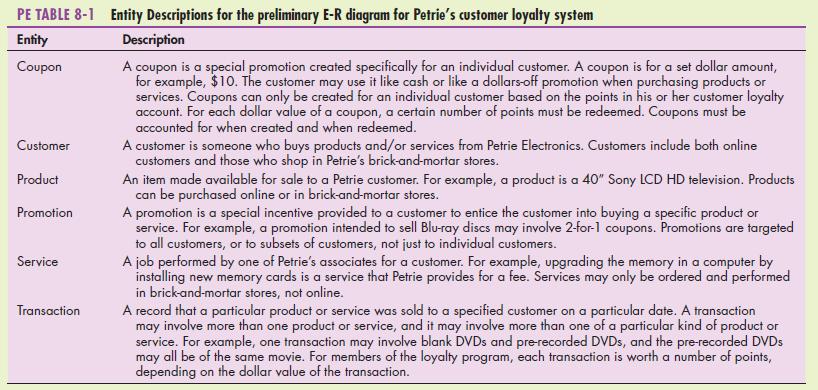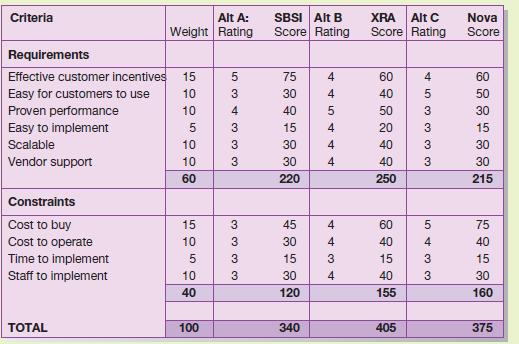Jim Watanabe, manager of the No Customer Escapes project, and assistant director of IT for Petrie Electronics,
Question:
Jim Watanabe, manager of the “No Customer Escapes” project, and assistant director of IT for Petrie Electronics, was sitting in the company cafeteria. He had just finished his house salad and was about to go back to his office when Stephanie Welch sat down at his table. Jim had met Stephanie once, back when he started work at Petrie. He remembered she worked for the database administrator.
“Hi, Jim, remember me?” she asked.
“Sure, Stephanie, how are you? How are things in database land?”
“Can’t complain. Sanjay asked me to talk to you about the database needs for your new customer loyalty system.”
Stephanie’s phone beeped. She pulled it out of her oversize bag and looked at it. She started to text as she continued to talk to Jim. “How far along are you on your database requirements?”
That’s kind of rude, Jim thought. Oh well. “We are still in the early stages. I can send you a very preliminary E-R diagram we have (PE Figure 8-1), along with a description of the major entities.”
“OK, that will help. I suspect that you won’t have too many new entities to add to what’s already in the system,”
Stephanie responded, still looking at her phone and still texting. She briefly looked up at Jim and smiled slightly before going back to texting. “Just send the E-R to me, and I’ll let you know if I have any questions.” She stood up, still looking at her phone. “Gotta go,” she said, and she walked away.
OK, Jim thought, I need to remember to send Stephanie the preliminary E-R we have. I should probably send her the entity descriptions too (PE Table 8-1), just in case. Jim stood up, carried his tray over to the recycling area of the cafeteria, and went back to his office.
When Jim got back to his office, Sanjay was waiting for him.
“I’ve got more information on those alternatives we talked about earlier,” Sanjay said. “I had one of my employees gather some data on how the alternatives might satisfy our needs.” (See the descriptions of the alternatives at the end of Chapter 6.) Sanjay handed Jim a short report. “The matrix shows the requirements and constraints for each alternative and makes it relatively easy to compare them.” (See PE Figure 8-2.)
“The matrix favors the XRA CRM system,” Jim said, after looking over the report. “It looks like their proposal meets our requirements the best, but the Nova group’s proposal does the best job with the constraints.”
“Yes, but just barely,” Sanjay said. “There is only a five point difference between XRA and Nova, so they are pretty comparable when it comes to constraints. But I think the XRA system has a pretty clear advantage in meeting our requirements.” “XRA seems to be pretty highly rated in your matrix in terms of all of the requirements. You have them ranked better than the other two proposals for implementation, scalability, and vendor support,” Jim said. “The ‘5’ you gave them for proven performance is one of the few ‘5’s you have in your whole matrix.”
“That’s because they are one of the best companies in the industry to work with,” Sanjay responded. “Their reputation is stellar.”
“This looks really promising,” Jim said. “Let’s see if reality matches what we have here. It’s time to put together the formal request for proposal. I’ll get that work started today. I hope that all three of these companies decide to bid.”


Figure 8-2

1. Review the data flow diagrams you developed for questions in the Petrie Electronics case at the end of Chapter 7 (or diagrams given to you by your instructor). Study the data flows and data stored on these diagrams and decide whether you agree with the team’s conclusion that the only six entity types needed are listed in the case and in PE Figure 8-1. If you disagree, define additional entity types, explain why they are necessary, and modify PE Figure 8-1 accordingly.
2. Again, review the DFDs you developed for the Petrie Electronics case (or those given to you by your instructor). Use these DFDs to identify the attributes of each of the six entities listed in this case plus any additional entities identified in your answer to Case Question 8-103. Write an unambiguous definition for each attribute. Then, redraw PE Figure 8-1 by placing the six (and additional) entities in this case on the diagram along with their associated attributes.
3. Using your answer to Case Question 8.104, designate which attribute or attributes form the identifier for each entity type. Explain why you chose each identifier.
4. Using your answer to Case Question 8.105, draw the relationships between entity types needed by the system. Remember, a relationship is needed only if the system wants data about associated entity instances. Give a meaningful name to each relationship. Specify cardinalities for each relationship and explain how you decided on each minimum and maximum cardinality on each end of each relationship. State any assumptions you made if the Petrie Electronics cases you have read so far and the answers to questions in these cases do not provide the evidence to justify the cardinalities you chose. Redraw your final E-R diagram in Microsoft Visio.
5. Now that you have developed in your answer to Case Question 8.106 a complete E-R diagram for the Petrie Electronics database, what are the consequences of not having an employee entity type in this diagram? Assuming only the attributes you show on the E-R diagram, would any attribute be moved from the entity it is currently associated with to an employee entity type if it were in the diagram? Why or why not?
6. Write project dictionary entries (using standards given to you by your instructor) for all the entities, attributes, and relationships shown in the E-R diagram in your answer to Case Question 8.106. How detailed are these entries at this point? What other details still must be filled in? Are any of the entities on the E-R diagram in your answer to Case Question 8.106 weak entities? Why? In particular, is the SERVICE entity type a weak entity? If so, why? If not, why not?
7. What date-related attributes did you identify in each of the entity types in your answer to Case Question 8.106? Why are each of these needed? Can you make some general observations about why date attributes must be kept in a database based on your analysis of this database?
Step by Step Answer:

Modern Systems Analysis And Design
ISBN: 9780134204925
8th Edition
Authors: Joseph Valacich, Joey George





